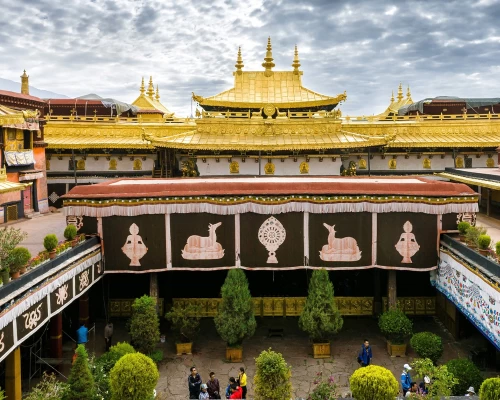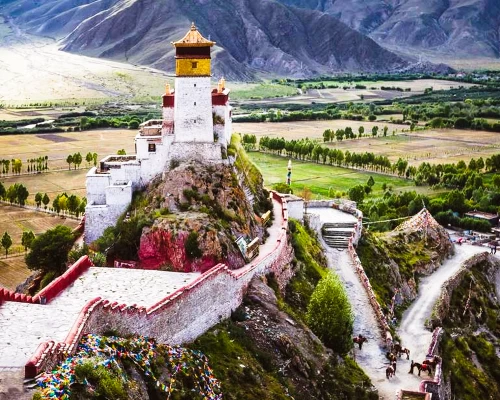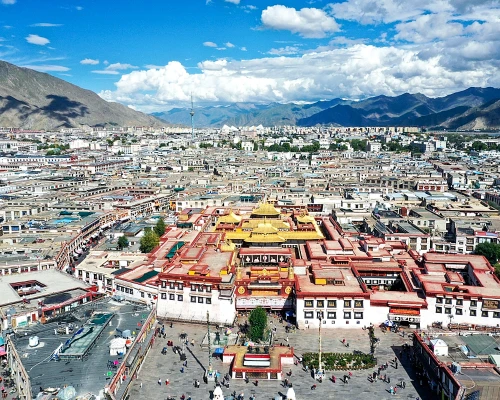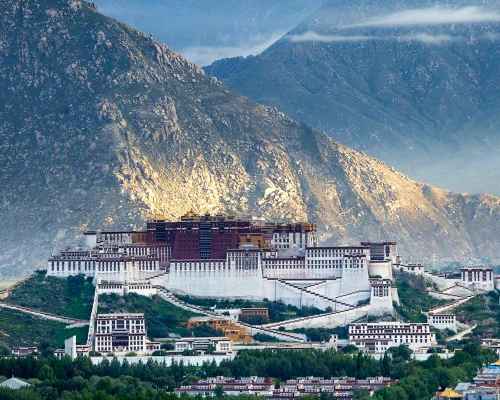Tibet is an independent territory, tucked up in the embrace of the Himalayas. Tibet stands as a land of immense cultural wealth and heritage, where the ancient traditions and spirituality connect to create a unique identity. Embarking on a Tibet 8-day tour, this captivating region offers a profound glimpse into its cultural and historical treasures. Lhasa, the spiritual heart of Tibet is located at an altitude of 3,650 meters above sea level. You can feel the very air carries a sense of mystique as you step into this sacred land. Lhasa, with its vibrant streets and historical landmarks, becomes an interesting and unique exploration.
The Potala Palace stands as an imposing monument in the rich history of Tibet. The towering walls of the Potala Palace speak the ancient stories of Dalai Lamas's past. As you ascend through its intricate chambers, the past unfolds, revealing a warehouse of antiquity that whispers the tales of an era long gone. Jokhang Temple, a sacred spiritual sanctuary draws pilgrims and curious wanderers by its timeless architecture that resonated with the devotion and has coursed through generations. As the oldest street in Lhasa, Barkhor Street is considered the center of the old city and a perfect place to learn the unique Tibetan Culture and Religion.
The journey stretches beyond the city limits heading towards Tsedang. This part of the journey is an acknowledgment of the serene and breathtaking landscapes that characterize Tibet. You will completely be submerged in the splendor and beauty of Tsedang. Tsedang unfolds its treasures as it leads you through its history. The Yumbulagang Palace is a living example of the royal dynasty of Tibet set among the magnificent nature. At an altitude of 3,900 meters, Gyantse Monastery greets you with its rich cultural tapestry. The Kumbum stupa within the Pelkor Chode Monastery captivates with its architecture and sculptures, encapsulating the essence of Tibetan Buddhist culture.
Shigatse embraces visitors into an era of monastic splendor with its ochre-colored landscape, and the chants of monks echo throughout the Tashilhunpo Monastery, a protector of Tibetan spiritual traditions. Here, the huge Maitreya Buddha statue stands as a protector of wisdom, keeping an eye on both the faithful and the curious.
Finally, traveling through Tibet offers a unique opportunity to explore its rich cultural legacy, breathtaking scenery, and spiritual importance. Each day of this 8 days in Tibet itinerary offers a brand-new adventure, from the time you land in the enchanting city of Lhasa, encircled by towering mountains and rich in history, to the serene towns of Tsedang, Gyantse, and Shigatse.
Major Highlights
Potala Palace
The Potala Palace is a magnificent essence of Tibet's history and spirituality. Rising impressively with its 13 stories, this architectural marvel served as the residence of the Dalai Lama lineage and a haven for Tibetan Buddhism.
Its imposing walls hide a rich embroidery of more than a thousand chambers, ten thousand shrines, and numerous statues that expose the profound connections between art, religion, and Culture in Tibet. The palace is a living history museum that not only tells the biography of the Dalai Lamas but also reflects the complex development of Tibet's cultural and political history, which makes it a beautiful example of Tibetan tradition and a persistent symbol of wonder.
Karola Glacier
The Karola Glacier offers a unique and appealing aspect of the region's attractiveness that is set against the wild surroundings of Tibet. The distinctive appearance of the Karola Glacier, outlined by layers of black and white brought on by pollution, stands out among the towering mountains and illustrates the complex connection between nature and human impact.
This glacier, which stands at an astounding elevation of 5,560 meters, is a geological marvel, a reminder of the ancient past, and a display of the magnificence of the Tibetan Plateau. The drive to the Karola glacier is a fascinating tour of Tibet's natural beauties because of its stark beauty and the surrounding panoramic views.
Jokhang Temple and Barkhor Street
The bustling Barkhor Street and the Jokhang Temple create a rich tapestry of Tibetan Buddhist culture and spirituality. The Jokhang Temple, a UNESCO World Heritage site, is the holiest of pilgrimage sites, drawing worshippers from all across Tibet to gather there in devotion. Its defined architecture, which combines Tibetan, Tang Dynasty, and Nepalese architectural forms, adds to its charm, and the golden top shines against the sky.
The oldest street in Lhasa Tour, Barkhor Street, is right next to it and is packed with activity, providing a tour through Tibetan culture, religion, and art. This lively lane is a treasure collection of handicrafts, from religious items to ornaments, making it the perfect location to learn about Tibetan heritage and buy unique souvenirs.
Highlights
- Explore the beauty of the iconic Potala Palace, Lhasa.
- Immerse yourself in the spirituality of Jokhang Temple, Lhasa.
- Stroll through the bustling lanes of Barkhor Street, Lhasa.
- Discover the historical significance of Samye Monastery, en route to Tsedang.
- Step back in time at Yumbulagang Palace, Tsedang, with panoramic valley views.
- Uncover legends and antiquity at Trandruk Monastery, Tsedang.
- Marvel at the intricate chapels of Pelkor Chode Monastery, Gyantse.
- Explore the spiritual heart of Tibet at Tashilhunpo Monastery, Shigatse.
- Engage with local culture, traditions, and handicrafts throughout the tour.
- Experience the breathtaking vistas of the Tibetan Plateau's majestic mountains and lakes.
Best Time for Tibet Cultural Tour
The best season for the Tibet Cultural Tour is from late spring to early Autumn (April- October). The temperature is mildest at this time, making it more pleasant for you to travel. While the peak season starts in late spring, summer offers peak accessibility and extended daylight.
Whereas, the autumn maintains fewer crowds and the landscapes remain stunning. This time period offers the best combination of warm weather and authentic experience of Tibetan Heritage.







.webp)

 based on 5 reviews
based on 5 reviews
